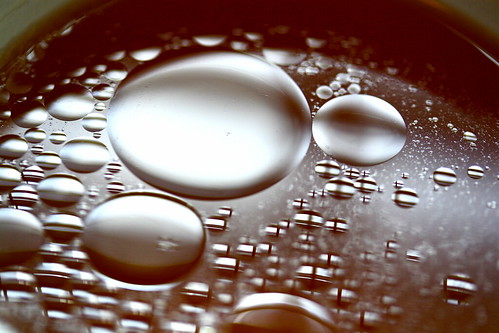
|
| chicken broth by Muffet, on Flickr |
Normally, I prefer making broth after roasting a whole chicken, as I'm fond of the flavors that develop from the Maillard reaction. I'm just not crazy about boiled meat.
But a while back, one of my local farmers had a deal going on pastured chicken necks & backs if you bought 20 pounds, so I figured I'd make broth and chicken meat.
Twenty pounds is a lot more than I thought it was. So my first go-round, before I'd decided to start the GAPS protocol, was the rather standard way of making chicken broth.
ordinary chicken broth
I put 10 lbs of the necks & backs into my stockpot, added a couple carcasses from roast chickens I had saved in my freezer, added the giblets from those same carcasses, added a nice glug of vinegar, and covered with vegetable broth.
After bringing to a boil, I skimmed off the scum that had formed using a slotted spoon, then reduced the heat to a simmer, and let go for about 4 hours.
After cooling, I strained through a colander to collect the broth, put in containers, and froze.
Then one is left to deal with the colander contents. One of the reasons I prefer using just bones is because of the sorting required to extract the meat. It is a messy job sorting through wet and greasy meat, bones, skin and "other".
GAPS chicken broth
The "other" is an issue with GAPS protocol - Dr. Campbell-McBride makes the point several times in the book that you should use all the bits you possibly can, grinding them up into the meat if necessary. That she made this point repeatedly, in both various text portions of the book as well as in the recipes section, seems to imply that she meant for us to really eat everything, even the "other" that I usually discard.
Are we really supposed to eat tendons and gristle?
To clarify this for myself, I went to Wikipedia and checked it out. About tendons, Wiki said:
Normal healthy tendons are composed mostly of parallel arrays of collagen fibers closely packed together. The dry mass of normal tendons, which makes up about 30% of the total mass with water, is composed of about 86% collagen, 2% elastin, 1–5% proteoglycans, and 0.2% inorganic components such as copper, manganese, and calcium.And yes, collagen (which melts into gelatin) and minerals definitely sounds like something Dr. Campbell-McBride would suggest we eat.
Wiki said about gristle that:
Hyaline cartilage (aka "Gristle") is a type of cartilage found on many joint surfaces. It is pearly bluish in colour with firm consistency and considerable collagen.So yes, that sounds like it should be included when she says to include all the gelatinous bits of meat.
I have to admit that the notion of eating the bits I normally threw away was not very appetizing at first thought. But then I considered...
I have never been an organ meat kind of gal, but have been including giblets in my broths forever. Even before I ever heard of TF, I used to boil up the turkey neck and giblets the night before Thanksgiving to make broth for the stuffing. And being a rather frugal sort, I chopped all the meat, including the liver (which some say makes broth taste too strong) and added them to the stuffing also. Since early childhood, I have always
So I know I can "hide" things in broth, even from myself, if boiled and chopped up small. And since both tendons and gristle are primarily collagen, if boiled long enough, they ought to dissolve into gelatin and not bother me.
So when I made my first batch of broth for GAPS, I simmered the necks & backs for 12 hours, way longer than usual.
Here's the thing, besides not finding any "other" bits to throw out after cooking for this long, most of the long bones were soft. The ends of them just dissolved, adding a lot more minerals to the broth, as well as allowing me to extract a lot of marrow. I don't normally expect to get marrow out of chicken bones; they're just too small. So this method produced what seems to me to produce a nutritionally superior broth.
As an added bonus, it was much easier to sort through the colander contents, just pulling out all the hard bits. Then I ran the meat and skin through a food processor.
From 10 pounds of necks & backs, I got 10 quarts of broth and 5 pints of chicken meat.
Taste testing before freezing proved to me that I had succeeded at "hiding" the intimidating bits from myself!
This post is linked to: Not "Baaad" Sundays, Sugar Free Sunday, Sunday Blog Love, Recipe of the Week, Scrumptious Sunday, Sundae Scoop, Weekend Wander, Friday Fun Party, Weekend Bloggy Reading, Shine on Friday, Simply Link, Friendship Friday, Frugal Friday, Country Homemaker Hop, Big Family Friday linkup, Craftastic Monday, Creative Corner, Inspire Me Monday, Just Something I Whipped Up, Made by you Monday


Making broth is something I really should learn how to do!
ReplyDeleteIt's very easy, and usually it's made from stuff you were going to throw out anyways. Hubby says it's "making food from garbage".
DeleteI can't wait to try this recipe sometime next weekend. :) Thanks for linking up at Friday Fun Party. Have a nice day!
ReplyDelete